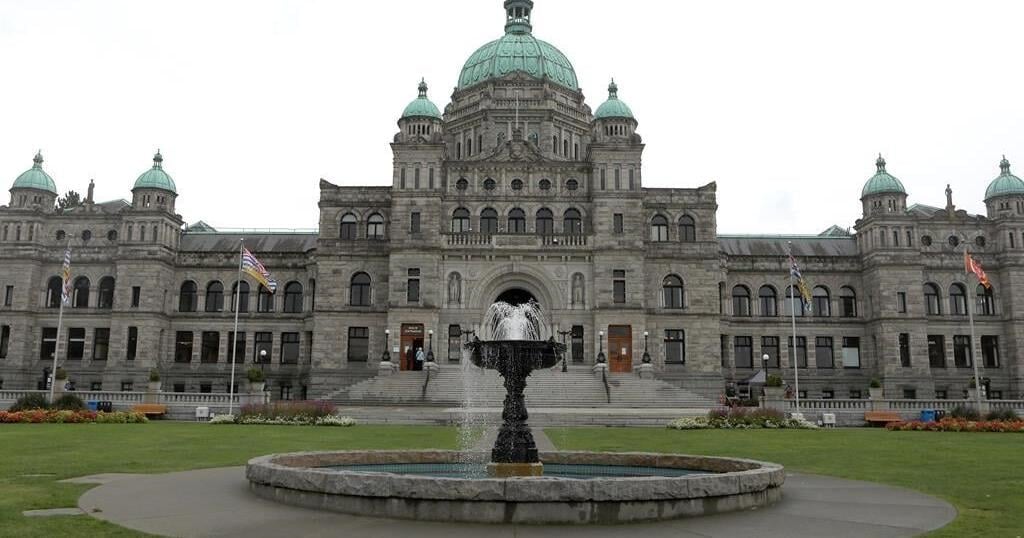VANCOUVER – Work crews have been busy in the British Columbia legislature over the summer, prying apart desks in the historic chamber and piling them up in hallways as they tried to work out how to fit in six more seats.
The renovation, with an estimated budget of $300,000, including new red carpet, was needed to accommodate 93 members of the legislature who will be sitting there after the Oct. 19 provincial election.
The carpenters and carpet layers weren’t the only ones pondering changes necessitated by the province’s rapidly growing population. B.C.’s major parties are also gearing up to fill those extra seats with help from voters in urban and suburban settings.
“With six new seats comes the need to recruit more volunteers and staff more campaigns, and, of course, the need to spend more money,” NDP campaign director Marie Della Mattia said in a statement.
“But when people are excited about your leader and your plan, raising money and recruiting volunteers is much easier.”
B.C. Conservative campaign director and executive director Angelo Isidorou said more seats means more effort — but also more potential gains.
“Generally speaking, fewer seats means fewer candidates to recruit,” Isidorou said in a written response to questions about the new ridings. “However, some of these redistributed ridings offer the Conservative Party an opportunity to reach more voters in a direct and local way.”
The six additional seats are all in major population centres in southern B.C.
Four are in the Metro Vancouver communities of Langley, Surrey, Burnaby and Vancouver, one is in the Victoria suburb of Langford, and another is in the urban core of Kelowna.
“These are the areas where the province is growing and the population requires additional representation to maintain that representation-by-population,” said Stewart Prest, a political science lecturer at the University of British Columbia.
“So, that’s the general reason why we’re seeing this redrawing of the map, and it’s worth noting that it really places additional weight on the need for parties to win votes in the urban areas of the province.”
David Black, an associate professor of communication and culture at Royal Roads University, said it would be a mistake to automatically assume the new urban seats will favour left-leaning parties such as the NDP.
Black said geographical factors create regional political leanings in places such as the Fraser Valley and the Okanagan, where centre-right parties have been favoured.
“I think this pattern holds in the sense that Langley and Kelowna are not the same as Burnaby, Surrey or even Langford, given how close Langford is to Greater Victoria,” he said.
“What we know from the political science literature is that where you live has a lot to do with how you vote. We think of the left-right spectrum as a political scale, but it is as much geographical as it is ideological.
“Places can choose people because places cluster qualities and features … that amplify and direct people toward certain voting preferences.”
While Black said the new seats shouldn’t be seen as automatically conferring advantage to the NDP, the trend over decades in B.C. showed a provincial electorate moving left, on average.
He said the best evidence of that came in the 2017 provincial election, when the NDP held on to 40 per cent of the popular vote despite another left-leaning party — the BC Greens — garnering almost 17 per cent of votes.
“The fact that the NDP was able to hold 40, even losing that much on their left with the Green Party at 17 (under former leader Andrew Weaver), suggests to me that this axis — which used to be centre-right — has tilted about five percentage points to the left,” Black said, noting population growth was happening mostly in urban centres.
“And so, this phenomenon whereby people in cities tend to vote, more or less, leaning NDP — or Green, for that matter — is the reason I believe we’ve seen this tilt.”
Black said this demographic trend put an imperative on centre-right parties to speak to urban voters more because “that’s where the ridings are.”
He said in an interview in mid-August that while poll numbers for the Conservatives had surged, seat projections on tracking sites still indicated a sizable advantage to the New Democrats due to the number of urban ridings.
“I think this partly reflects a problem that the Conservatives have to solve, and that is the question of vote efficiency,” Black said. “The Conservatives, according to the poll data, are running up the popular vote totals enormously — well over 50 per cent — in the north, but there are relatively few ridings up there whereas the NDP is more competitive in the cities where of course there are more ridings. That’s the path to power.”
Prest cautioned against assuming an NDP advantage.
“They still need to maintain those links with those voters,” he said of the party and voters in the new ridings. “And it also creates opportunities for other parties to try to make inroads, as well.”
The new district boundaries had also meant vast changes in electorate composition for some existing ridings, compared with the last election.
“There’s going to be, I think, a certain amount of reacquainting necessary for voters when they come to pay attention to who is running to represent them in the election,” Prest said, adding even small boundary changes can make a big difference in a close vote.
“Every neighbourhood can make a little bit of difference at the margins,” he said. “And it is specifically at those ridings where essentially the town or the city meets the country, if you like — where the urban meets the suburban or rural areas of the province — that (boundary) changes can have a real effect.”
This report by The Canadian Press was first published Sept. 22, 2024.
— With files from Dirk Meissner in Victoria

























